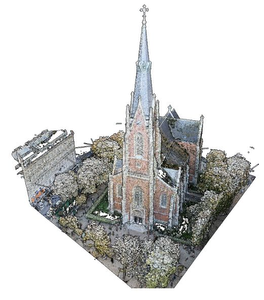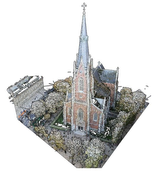Information
- Publication Type: Journal Paper with Conference Talk
- Workgroup(s)/Project(s):
- Date: August 2020
- Journal: ISPRS - International Archives of the Photogrammetry, Remote Sensing and Spatial Information Sciences
- Volume: XLIII-B2-2020
- Open Access: yes
- Location: online
- Lecturer: Johannes Otepka
- ISSN: 1682-1750
- Event: XXIV ISPRS Congress (2020 edition)
- DOI: 10.5194/isprs-archives-XLIII-B2-2020-293-2020
- Call for Papers: Call for Paper
- Conference date: 31. August 2020
– 2. September 2020
- Pages: 293 – 300
Abstract
Nowadays, point clouds are the standard product when capturing reality independent of scale and measurement technique. Especially, Dense Image Matching (DIM) and Laser Scanning (LS) are state of the art capturing methods for a great variety of applications producing detailed point clouds up to billions of points. In-depth analysis of such huge point clouds typically requires sophisticated spatial indexing structures to support potentially long-lasting automated non-interactive processing tasks like feature extraction, semantic labelling, surface generation, and the like. Nevertheless, a visual inspection of the point data is often necessary to obtain an impression of the scene, roughly check for completeness, quality, and outlier rates of the captured data in advance. Also intermediate processing results, containing additional per-point computed attributes, may require visual analyses to draw conclusions or to parameterize further processing. Over the last decades a variety of commercial, free, and open source viewers have been developed that can visualise huge point clouds and colorize them based on available attributes. However, they have either a poor loading and navigation performance, visualize only a subset of the points, or require the creation of spatial indexing structures in advance. In this paper, we evaluate a progressive method that is capable of rendering any point cloud that fits in GPU memory in real time without the need of time consuming hierarchical acceleration structure generation. In combination with our multi-threaded LAS and LAZ loaders, we achieve load performance of up to 20 million points per second, display points already while loading, support flexible switching between different attributes, and rendering up to one billion points with visually appealing navigation behaviour. Furthermore, loading times of different data sets for different open source and commercial software packages are analysed.
Additional Files and Images
Additional images and videos
Additional files
Weblinks
BibTeX
@article{OTEPKA-2020-PPC,
title = "Efficient Loading and Visualization of Massive Feature-Richt
Point Clouds Without Hierarchical Acceleration Structures",
author = "Johannes Otepka and Gottfried Mandlburger and Markus
Sch\"{u}tz and Norbert Pfeifer and Michael Wimmer",
year = "2020",
abstract = "Nowadays, point clouds are the standard product when
capturing reality independent of scale and measurement
technique. Especially, Dense Image Matching (DIM) and Laser
Scanning (LS) are state of the art capturing methods for a
great variety of applications producing detailed point
clouds up to billions of points. In-depth analysis of such
huge point clouds typically requires sophisticated spatial
indexing structures to support potentially long-lasting
automated non-interactive processing tasks like feature
extraction, semantic labelling, surface generation, and the
like. Nevertheless, a visual inspection of the point data is
often necessary to obtain an impression of the scene,
roughly check for completeness, quality, and outlier rates
of the captured data in advance. Also intermediate
processing results, containing additional per-point computed
attributes, may require visual analyses to draw conclusions
or to parameterize further processing. Over the last decades
a variety of commercial, free, and open source viewers have
been developed that can visualise huge point clouds and
colorize them based on available attributes. However, they
have either a poor loading and navigation performance,
visualize only a subset of the points, or require the
creation of spatial indexing structures in advance. In this
paper, we evaluate a progressive method that is capable of
rendering any point cloud that fits in GPU memory in real
time without the need of time consuming hierarchical
acceleration structure generation. In combination with our
multi-threaded LAS and LAZ loaders, we achieve load
performance of up to 20 million points per second, display
points already while loading, support flexible switching
between different attributes, and rendering up to one
billion points with visually appealing navigation behaviour.
Furthermore, loading times of different data sets for
different open source and commercial software packages are
analysed.",
month = aug,
journal = "ISPRS - International Archives of the Photogrammetry, Remote
Sensing and Spatial Information Sciences",
volume = "XLIII-B2-2020",
issn = "1682-1750",
doi = "10.5194/isprs-archives-XLIII-B2-2020-293-2020",
pages = "293--300",
URL = "https://www.cg.tuwien.ac.at/research/publications/2020/OTEPKA-2020-PPC/",
}


 paper
paper
